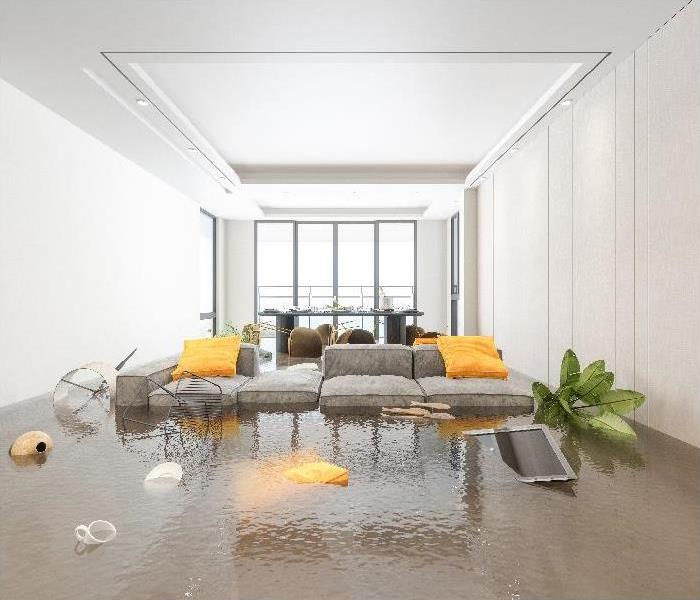What Should I Do First When Water Comes Into My Pensacola Home?
7/12/2020 (Permalink)
SERVPRO technicians can clean up and restore your Pensacola home from flood damage using their advanced equipment and restoration methods
When strong storms deliver damage to local Florida properties, no matter what the damage is, they all have a common need: for the cleanup to begin as soon as possible. This is particularly important when flood damage is within the structure. One of the first thoughts a Pensacola homeowner might be that everything within the loss area got ruined beyond repair. Still, through the professional restoration methods, SERVPRO technicians use, recovery of both structure and contents may be possible. Only if it safe to do should you do the following actions:
• Turn off the electricity to the home if there is a danger of water coming into contact with plugs or outlets
• Remove valuables and essential documents
• Pick up small items off the floor
• Put furniture in loss area on blocks or otherwise block the wood from coming into contact with wet carpet to avoid staining
Can SERVPRO Clean Insulation with Flood Damage?
When water enters and causes flood damage in a Pensacola home, the areas that generally need the most restoration attention are the walls, floors, and contents. Once sheetrock wicks the water, it cannot get returned to a state for reuse and requires removal. The techs do this using flood cuts. They measure carefully with their detection equipment above the waterline by several inches and cut off the water-laden portion. This exposes the insulation. In a clean water event in a home, if the insulation got used within the walls, it has potential for reuse after drying, and the techs collect it with a vacuum specifically for insulation. However, with floodwater, generally, anything that absorbs it is a loss, including insulation.
How Do I Know If Flood Water Has Contaminants?
Part of the comprehensive training that SERVPRO technicians undergo is the handling of biohazard materials, which they have certification in Biohazard #17-64-1560497. With this training, you can rely on the techs to:
• Test the water for the presence of bacteria or pathogens
• Choose the appropriate cleaning method
• Safely extract and dispose of the water
Collective Actions During Mitigation of Flood Loss
If there was any delay beyond 48 hours or the water tested positive for harmful elements, it increases the loss to the property. The sheetrock, flooring, and furnishings that absorbed the water require safe removal and disposal. Some homes with damage from just an inch of floodwater in the home require removal of the sheetrock and flooring to the point the subfloor and framework are all that is left.
Wet carpet can cause injury due to its weight, and the techs extract the water and then cut it into strips for disposal according to local regulations for hazardous waste.
During the initial cleanout of loss items, nothing gets discarded without the knowledge and approval of the adjuster and/or homeowner. The techs do many actions to make the process organized:
• Creating a document that includes photos and descriptions of each loss item
• Providing a copy to both the homeowner and adjuster to expedite insurance claims
• Ensuring each part of the restoration process has coverage under the homeowners' policy to avoid out of pocket expenses
How Does SERVPRO Dry Properties So Quickly?
When setting up the equipment to dry a home, SERVPRO techs use their moisture detection equipment to determine the accurate scale of the damage in the house. Visually, the water loss may appear to stop at a certain point when, in fact, it migrated under the flooring to a broader area. Once the true scope of the area that requires drying gets determined, the techs set up a large number of air movers and dehumidifiers to bring down the interior air moisture levels all at once.
Mold Prevention is a Standard Part of Mitigation
Another integral part of the ongoing education process for the techs is learning about mold mitigation. They hold certification for mold remediation #MRSR2768, and workers know the safety protocols for removal of dried colonies to inhibit the potential for the spread of airborne spores through the use of their manual abatement techniques and equipment for air quality, such as air scrubbers. After drying the property, the surfaces get a thorough wipe down with professional-grade antimicrobials. In areas where colonies got removed, it is common for those places to get treated with an antimicrobial sealant to halt any return of the issue before reconstruction.
SERVPRO of West Pensacola (850) 469-1160 for assistance with flood damage in your home. The technicians are available 24/7, arrive quickly, and restore your home to its preloss condition.





 24/7 Emergency Service
24/7 Emergency Service
